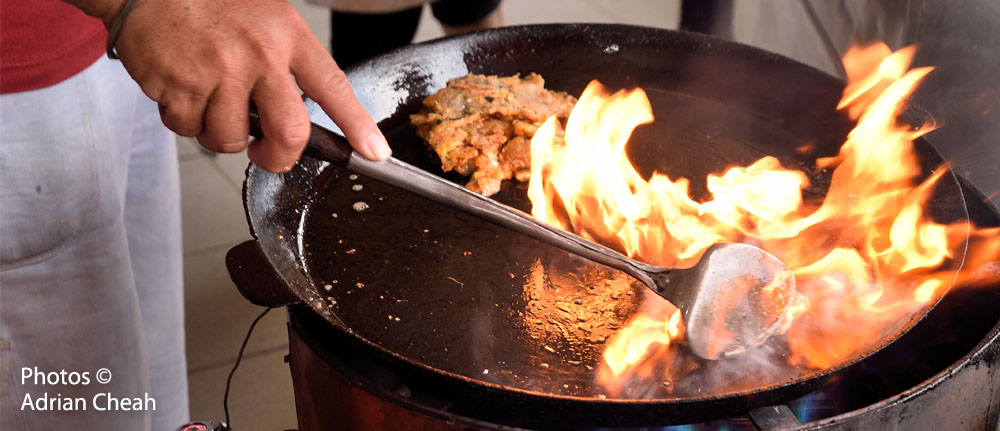Penang's sizzling century-old oh chien (oyster omelette) recipe

In Penang, "oh chien" (in Hokkien) means "fried oysters" but it commonly refers to the oyster omelette dish. There are many varieties available in Malaysia and even more so throughout Southeast Asia, China and Taiwan.
The main ingredients for Penang-style oh chien include a batter (tapioca flour, rice flour or a mixture of both), chopped chives, eggs, fresh oysters and a special blend of seasoning. The dish is usually stir-fried over high heat and served with a garlic chilli sauce on the side. Some stalls garnish their dish with coriander leaves, adding more aroma to the omelette.

Here, I will only focus on oh chien at one of my favourite stalls in Penang, located at Kedai Kopi Seng Thor along Lebuh Carnarvon. You can catch Mr Lim Nan Sheng in his element preparing oh chien with an age-old recipe that spans three generations.
His grandfather, Mr Lim Song Shen (林松森) obtained the recipe and cooking methods from his hometown of Shandong, a coastal province in China. He boarded a ship and migrated to Penang to start life anew, filled with the hope of a brighter future. Little did he realise that almost a century later, his grandson would be upholding his legacy with pride over a dish he perfected.

Song Shen first set up a stall selling oh chien at a coffeeshop located at the junction of Carnavon Lane and Carnavon Street. A few decades later, he relocated it opposite the road to where Kedai Kopi Seng Thor stands today. From then, he plied his trade so well as to established its roots and gain popularity among the locals. He won the hearts of many including that of my late father. Dad would claim that Song Shen served the best plate of oh chien in Penang island. He would add, "Anything cooked with lard always tastes better".
In the 1960s, his son Teong Liang took over the business and continued to serve delicious plates of oh chien, maintaining its quality. Fast forward five decades later, he too retired as age caught up. In 2013 after an eye operation, Teong Liang decided to call it a day and handed over the reins to his son Nan Sheng. Nan Sheng by then was already a master in his own right, honing his skills under the tutelage of his father for decades.

Let us take a close look at Nan Sheng and the art of making oh chien. Onto a hot cast iron flat griddle, he adds the batter (a secret mix of various types of flour) and chopped chives. He then cracks in a couple of eggs and stirs the ingredients well. Onto the griddle, he adds "tonnes" of oil, almost deep frying the mixture. Some health freaks would scream murder. Well, without the obscene amount of oil and high heat, the batter would not be able to crisp and that would leave the dish a gooey mess.


Some take consolation that because they think that Nan Sheng uses vegetable oil, it is a healthier option as opposed to lard used by his grandfather. I beg to differ.
We now know that animal fat, like duck fat and lard is mostly saturated fat, which means it stands up better to high heat than its vegetable counterpart. Reduced oxidation in animal fat means it is less susceptible to the toxins and carcinogens generated by vegetable fat.
We also know that our brains are extremely rich in fat. Almost two-thirds are fat and a full 20 per cent of that fat is an omega-3 fatty acid called docosahexanoic acid (DHA). Plant food does not contain DHA. DHA is a wondrous fatty acid that the human body cannot function without and it is precious and irreplaceable. If I have to choose between animal fat and vegetable fat, hands down I would go for the former. Also, butter over margarine anytime!


Back to oh chien, Nan Sheng piles up the crispy omelette batter onto one side of the griddle and dishes out the excess oil. He then stir-fries the oysters for under one minute in high heat with his special blend of seasoning. Fire usually leaps into the griddle providing a dramatic photo opportunity. It also imbues the dish with a smoky aroma. I like mine cooked with chilli – he is happy to add that, thus making the dish more aromatic and fiery.

The mouth-watering plate of oh chien is accompanied by a sour yet spicy garlic chilli sauce.
I enjoy the lightly cooked oysters that are "lemak" (rich) and plump. The omelette was crisp around the edges and has a fluffy-soft centre. I appreciate that Nan Sheng took great care and effort in preparing every plate.
If you are allergic to greasy food, stay away from oh chien. If you want to indulge then look past the amount of oil used to cook this dish. As explained above, it is all necessary.
How many hawker stalls are there left in Penang that would share this lineage of succession? Your guess would be as good as mine. The number would definitely be falling since the younger generation would opt for a more comfortable lifestyle rather than slaving over a stove to eke out a living.
Also within our homes, it is vital to share and teach the younger generation their grandmother's recipes before all is lost. I am glad my daughter shows a keen interest in learning and I am able to impart my cooking knowledge to her. Rest assured that in future, her family would be dining on sambal babi, tau eu bak, nasi ulam, jiu hu char, kari kapitan, acar hu and more.
---------------------------------------------------------
Written and photographed by Adrian Cheah © All rights reserved
30 August 2020
--------------------------------------------------------
Kedai Kopi Seng Thor
160 Lebuh Carnarvon, 10100 Penang
GPS Coordinates: N 5 24.915 E 100 20.084
Opens: 12.00noon – 5pm
Closed twice every month on alternate Wednesdays.